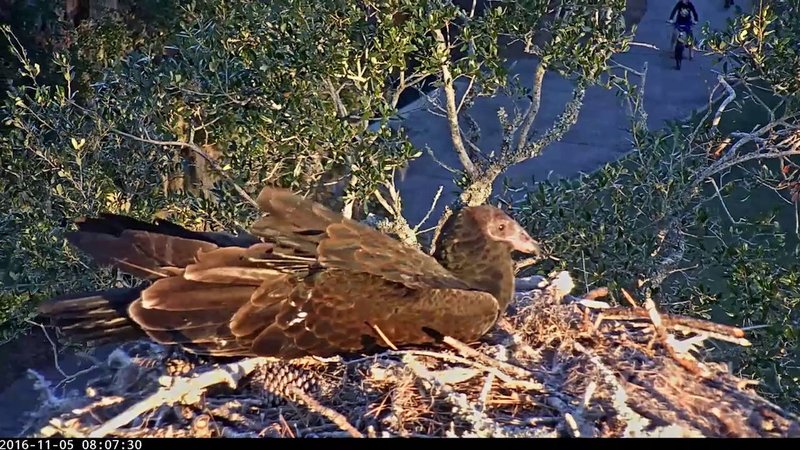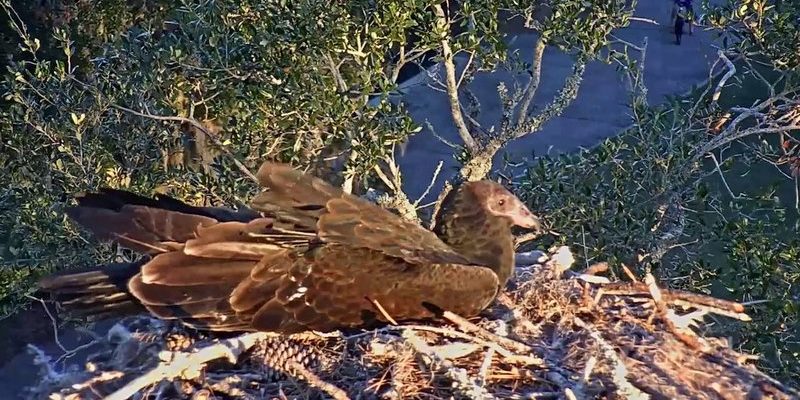
So, let’s dive into the world of the turkey vulture. We’ll explore where they nest, how they choose their mates, and what their young ones need to grow up. By the end, you’ll have a solid understanding of these amazing birds and their nesting behaviors.
Where Do Turkey Vultures Nest?
Turkey vultures are not picky about their nesting locations, which is part of their charm. They prefer to find cozy spots in secluded areas where they can lay their eggs away from prying eyes. Think of them as the introverted artists of the bird world—content to stay out of the spotlight.
They often choose to nest on rocky ledges, in caves, or even in abandoned structures like barns. You might wonder why they opt for these unconventional spots. Well, nesting in these areas offers protection from predators while also providing some shelter from the elements. Plus, it’s a great way to keep an eye on the surrounding landscape for any potential food sources.
Here’s a fun fact: turkey vultures don’t actually make traditional nests. Instead, they lay their eggs directly on the ground or in a hollowed-out area, relying on the surrounding environment for a little bit of insulation. This minimalist approach is fascinating and speaks to their adaptability.
The Nesting Process
The nesting process for turkey vultures is relatively straightforward but still an essential part of their lifecycle. During the breeding season, which peaks in spring, male turkey vultures perform elaborate courtship displays to attract a mate. You might imagine it as a dance—they will often spread their wings, create a series of hissing sounds, and show off those striking white wing tips.
Once a pair forms, they’ll work together to find a suitable nesting site. After selecting a location, the female will lay anywhere from one to three eggs. These eggs are typically a pale, speckled color—great for blending into their surroundings. Here’s the thing: both parents take turns monitoring the eggs, ensuring they’re safe and warm.
Incubation lasts about 30 to 40 days, depending on the temperature and environmental conditions. During this time, the parents are vigilant, keeping the area quiet and secure. Their commitment is truly admirable, wouldn’t you agree?
Egg Development and Hatching
As the incubation period progresses, the eggs undergo significant development. Inside the eggs, the embryos are growing and developing into tiny, fluffy chicks. Like many birds, turkey vulture chicks rely on their parents for warmth and protection.
When the chicks are ready to hatch, they use a sharp little egg tooth to break through the shell. This process can take some time, and you might imagine it as a young artist finally breaking free from their canvas. Once they emerge, the chicks are covered in fine gray down, looking quite different from their parents at first.
Interestingly, turkey vulture chicks are born altricial, meaning they are helpless at hatching. This is where parental care becomes crucial. The parents will feed the chicks by regurgitating food, which might sound a bit unappetizing, but it’s a vital part of their growth.
Rearing the Young
Once the chicks are out of their shells, the real adventure begins! Parents will tirelessly feed their young, bringing them bits of carrion. It might surprise you to know that turkey vultures have a keen sense of smell, which helps them locate their favorite meals.
As the chicks grow, they start to develop feathers and gain strength. It’s like watching a young artist hone their craft—each day brings new skills and discoveries. After about 10 to 12 weeks, the chicks are typically ready to leave the nest. During this time, they’ll learn how to fly and forage for food, building independence.
It’s worth noting that during the rearing process, the family often stays close together. You might see the young vultures hanging around the nest, practicing their flying and absorbing lessons from their parents.
When Do Turkey Vultures Leave the Nest?
The moment a young turkey vulture takes flight for the first time is truly a sight to behold. After they’ve spent several weeks learning and growing, they’ll begin to fledge, or develop the feathers necessary for flight. When they finally leave the nest, it’s a bit of a bittersweet moment for the parents, who have nurtured them through this journey.
Once fledging occurs, they typically remain dependent on their parents for a little while longer. Young vultures may still rely on their parents to teach them how to find food and navigate their environment. It’s like sending a child off to college but still keeping in touch for advice.
This phase can last several months as the young birds learn to survive on their own. Ultimately, they’ll become fully independent and continue the lifecycle by finding their own mates and nesting sites.
Turkey Vulture Lifespan and Maturity
Turkey vultures are often long-lived birds. In the wild, they can live for about 10 to 20 years, though some individuals have been known to reach even older ages. That longevity is impressive, especially considering the challenges they face in the wild.
Maturity typically occurs around 5 to 6 years old. During this time, the vultures are fully developed and ready to start their own families. They tend to mate for life, forming strong bonds with their partners similar to a well-established friendship. These lifelong partnerships contribute to their success as parents and maintain stability within their populations.
These resilient birds show us how nature has a unique way of balancing everything. From their nesting habits to the way they raise their young, turkey vultures play an essential role in the ecosystem, helping to keep it clean and healthy.
The Importance of Turkey Vultures in the Ecosystem
Turkey vultures may not get all the glamor that other birds do, but their role in the ecosystem is vital. By feeding primarily on carrion, they help to clean up the environment by consuming dead animals. This scavenging behavior prevents the spread of disease and encourages a healthier ecosystem.
Imagine a world without these birds—there would be dead animals left to rot, attracting pests and potentially spreading illness. Turkey vultures help maintain balance in nature, making them unsung heroes in the animal kingdom.
Moreover, their presence indicates a healthy environment. When turkey vultures thrive, it often means that the ecosystem is functioning well. So, the next time you see a turkey vulture soaring overhead, take a moment to appreciate the important role they play.
In conclusion, turkey vultures may seem like simple scavengers, but their nesting habits and lifecycle are filled with fascinating details and responsibilities. From choosing their mates to raising their young, these birds demonstrate resilience and adaptability. By understanding their behaviors, we can appreciate them not just as scavengers but as essential contributors to our ecosystem.

